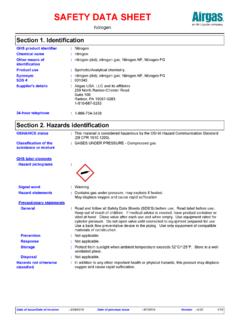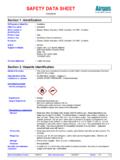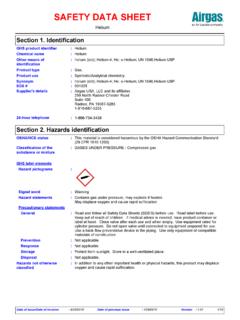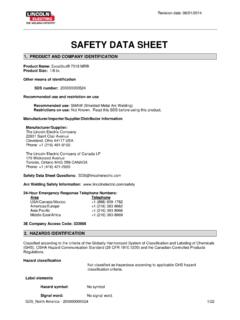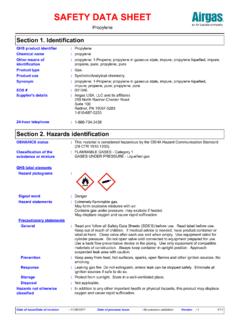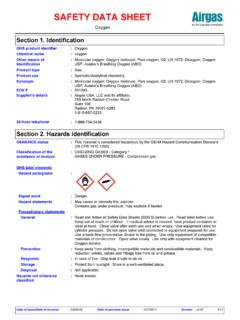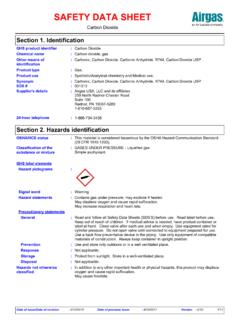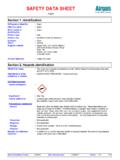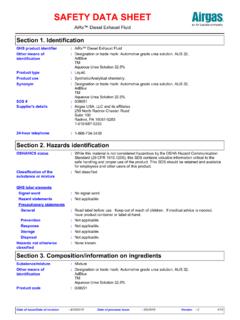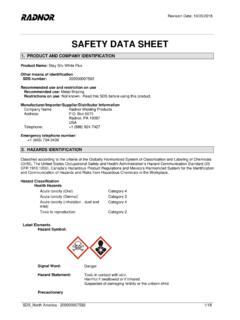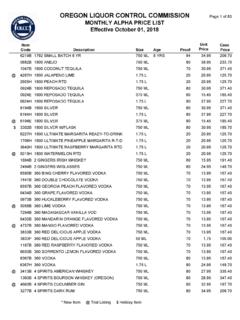Transcription of SAFETY DATA SHEET - Airgas
1 Carbon Dioxide, Solid or Dry IceDry ice; carbonic data SHEETGHS product identifierOther means of identificationProduct typeSection 1. Identification:::Chemical name:Carbon dioxide, solidSupplier's details:Carbon Dioxide, Solid or Dry IceProduct use:Synthetic/Analytical :Dry ice; carbonic anhydrideSDS #:001091 Airgas USA, LLC and its affiliates259 North Radnor-Chester RoadSuite 100 Radnor, PA 19087-52831-610-687-52531-866-734-3438:2 4-hour telephoneSection 2. Hazards identificationNot classified by Globally Harmonized System of Classification and Labeling (GHS).Classification of the substance or mixture:Signal word:WarningHazard statements:May displace oxygen and cause rapid increase respiration and heart cause statementsPrevention:Not :Not :Not :Not label elementsGeneral:Read label before use. Keep out of reach of children.
2 If medical advice is needed,have product container or label at not otherwise classified:Contact with cryogenic liquid can cause frostbite and cryogenic status:Not 3. Composition/information on ingredientsCarbon Dioxide100124-38-9 Ingredient nameCAS number%Chemical name:Carbon dioxide, solidOther means of identification:Dry ice; carbonic anhydrideCAS number:124-38-9 Substance/mixtureCAS number/other identifiers:SubstanceAny concentration shown as a range is to protect confidentiality or is due to batch code:001091 Date of issue/Date of revision:11/10/2018 Date of previous issue:6/26/2018 Version:11/10 Carbon Dioxide, Solid or Dry IceSection 3. Composition/information on ingredientsThere are no additional ingredients present which, within the current knowledge of the supplier and in the concentrations applicable, are classified as hazardous to health or the environment and hence require reporting in this exposure limits, if available, are listed in Section out mouth with water.
3 Remove victim to fresh air and keep at rest in a position comfortable for breathing. If material has been swallowed and the exposed person is conscious, give small quantities of water to drink. Do not induce vomiting unless directed to do so by medical personnel. Get medical attention if symptoms flush eyes with plenty of water, occasionally lifting the upper and lower eyelids. Check for and remove any contact lenses. Get medical attention if irritation contaminated skin with plenty of water. Remove contaminated clothing and shoes. Get medical attention if symptoms victim to fresh air and keep at rest in a position comfortable for breathing. Get medical attention if symptoms 4. First aid measuresEye contactSkin contactInhalationIngestion::::Protection of first-aiders:No action shall be taken involving any personal risk or without suitable to physician:Treat symptomatically.
4 Contact poison treatment specialist immediately if large quantities have been ingested or of necessary first aid measuresSpecific treatments:No specific important symptoms/effects, acute and delayedInhalation:May be harmful if inhaled. May cause respiratory be harmful if swallowed and enters airways.:IngestionSkin contact:Harmful if absorbed through the skin. May cause skin cause eye irritation.:Eye contactOver-exposure signs/symptomsSkin contactIngestionInhalationNo specific specific specific data .:::Eye contact:No specific acute health effectsSee toxicological information (Section 11)Indication of immediate medical attention and special treatment needed, if necessaryFrostbite:Try to warm up the frozen tissues and seek medical 5. Fire-fighting measuresHazardous thermal decomposition productsSpecific hazards arising from the chemicalDecomposition products may include the following materials:carbon dioxidecarbon monoxideNo specific fire or explosion an extinguishing agent suitable for the surrounding media::None extinguishing media:Unsuitable extinguishing media:Date of issue/Date of revision:11/10/2018 Date of previous issue:6/26/2018 Version:12/10 Carbon Dioxide, Solid or Dry IceSection 5.
5 Fire-fighting measuresPromptly isolate the scene by removing all persons from the vicinity of the incident if there is a fire. No action shall be taken involving any personal risk or without suitable should wear appropriate protective equipment and self-contained breathing apparatus (SCBA) with a full face-piece operated in positive pressure protective equipment for fire-fighters:Special protective actions for fire-fighters:Section 6. Accidental release measuresEnvironmental precautionsPersonal precautions, protective equipment and emergency proceduresMove containers from spill area. Prevent entry into sewers, water courses, basements or confined areas. Vacuum or sweep up material and place in a designated, labeled waste container. Dispose of via a licensed waste disposal contractor. Note: see Section 1 for emergency contact information and Section 13 for waste disposal.
6 ::No action shall be taken involving any personal risk or without suitable surrounding areas. Keep unnecessary and unprotected personnel from entering. Do not touch or walk through spilled material. Put on appropriate personal protective dispersal of spilled material and runoff and contact with soil, waterways, drains and sewers. Inform the relevant authorities if the product has caused environmental pollution (sewers, waterways, soil or air).Large spill:Move containers from spill area. Vacuum or sweep up material and place in a designated, labeled waste container. Dispose of via a licensed waste disposal spill:Methods and materials for containment and cleaning upFor non-emergency personnelFor emergency responders:If specialized clothing is required to deal with the spillage, take note of any information in Section 8 on suitable and unsuitable materials.
7 See also the information in "For non-emergency personnel".Section 7. Handling and storageAdvice on general occupational hygieneConditions for safe storage,including any incompatibilitiesEating, drinking and smoking should be prohibited in areas where this material is handled, stored and processed. Workers should wash hands and face before eating,drinking and smoking. Remove contaminated clothing and protective equipment before entering eating areas. See also Section 8 for additional information on hygiene in accordance with local regulations. Store in original container protected from direct sunlight in a dry, cool and well-ventilated area, away from incompatible materials (see Section 10) and food and drink. Keep container tightly closed and sealed until ready for use. Containers that have been opened must be carefully resealed and kept upright to prevent leakage.
8 Do not store in unlabeled containers. Use appropriate containment to avoid environmental contamination. See Section 10 for incompatible materials before handling or use.::Protective measuresPut on appropriate personal protective equipment (see Section 8).:Precautions for safe handlingSection 8. Exposure controls/personal protectionControl parametersOccupational exposure limitsDate of issue/Date of revision:11/10/2018 Date of previous issue:6/26/2018 Version:13/10 Carbon Dioxide, Solid or Dry IceSection 8. Exposure controls/personal protectionCarbon DioxideACGIH TLV (United States, 3/2017). STEL: 54000 mg/m 15 minutes. STEL: 30000 ppm 15 minutes. TWA: 9000 mg/m 8 hours. TWA: 5000 ppm 8 REL (United States, 10/2016). STEL: 54000 mg/m 15 minutes. STEL: 30000 ppm 15 minutes. TWA: 9000 mg/m 10 hours. TWA: 5000 ppm 10 PEL (United States, 6/2016).
9 TWA: 9000 mg/m 8 hours. TWA: 5000 ppm 8 PEL 1989 (United States, 3/1989). STEL: 54000 mg/m 15 minutes. STEL: 30000 ppm 15 minutes. TWA: 18000 mg/m 8 hours. TWA: 10000 ppm 8 nameExposure limitsHand protectionBased on the hazard and potential for exposure, select a respirator that meets the appropriate standard or certification. Respirators must be used according to a respiratory protection program to ensure proper fitting, training, and other important aspects of , impervious gloves complying with an approved standard should be worn at all times when handling chemical products if a risk assessment indicates this is eyewear complying with an approved standard should be used when a risk assessment indicates this is necessary to avoid exposure to liquid splashes, mists,gases or dusts. If contact is possible, the following protection should be worn, unless the assessment indicates a higher degree of protection: SAFETY glasses with protectionRespiratory protection:::Body protectionPersonal protective equipment for the body should be selected based on the task being performed and the risks involved and should be approved by a specialist before handling this product.
10 :Environmental exposure controls:Emissions from ventilation or work process equipment should be checked to ensure they comply with the requirements of environmental protection legislation. In some cases, fume scrubbers, filters or engineering modifications to the process equipment will be necessary to reduce emissions to acceptable engineering controls:Good general ventilation should be sufficient to control worker exposure to airborne hands, forearms and face thoroughly after handling chemical products, before eating, smoking and using the lavatory and at the end of the working techniques should be used to remove potentially contaminated contaminated clothing before reusing. Ensure that eyewash stations and SAFETY showers are close to the workstation measures:Individual protection measuresSkin protectionOther skin protection:Appropriate footwear and any additional skin protection measures should be selected based on the task being performed and the risks involved and should be approved by a specialist before handling this of issue/Date of revision:11/10/2018 Date of previous issue:6/26/2018 Version:14/10 Carbon Dioxide, Solid or Dry IceSection 9.
